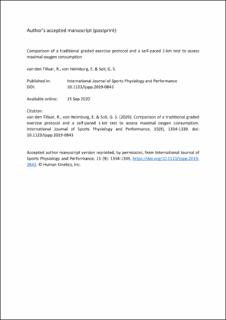| dc.contributor.author | van den Tillaar, Roland | |
| dc.contributor.author | von Heimburg, Erna | |
| dc.contributor.author | Solli, Guro Strøm | |
| dc.date.accessioned | 2021-02-11T12:35:49Z | |
| dc.date.available | 2021-02-11T12:35:49Z | |
| dc.date.created | 2021-01-11T18:34:27Z | |
| dc.date.issued | 2020 | |
| dc.identifier.citation | van den Tillaar, R., von Heimburg, E. & Soli, G. S. (2020). Comparison of a traditional graded exercise protocol with a self-paced 1-km test to assess maximal oxygen consumption. International Journal of Sports Physiology and Performance (IJSPP), 15(9), 1334-1339. doi: | en_US |
| dc.identifier.issn | 1555-0273 | |
| dc.identifier.uri | https://hdl.handle.net/11250/2727431 | |
| dc.description.abstract | Purpose: To compare the assessment of the maximal oxygen consumption (VO2max) in a traditional graded exercise test (GXT) with a 1-km self-paced running test on a nonmotorized treadmill in men and women. Methods: A total of 24 sport-science students (12 women: age 23.7 [7.7] y, body height 1.68 [0.02] m, body mass 66.6 [4.3] kg; 12 men: 22.1 [3.1] y, body height 1.82 [0.06] m, body mass 75.6 [11.0] kg) performed a traditional GXT on a motorized treadmill and a 1-km self-paced running test on a nonmotorized treadmill. VO2max, blood lactate, heart rate, and rating of perceived exertion, together with running velocity and duration at each test, were measured. Results: The main findings of the study were that the 1-km test produced significantly higher VO2max values (53.2 [9.9] vs 51.8 [8.8] mL/kg/min ) and blood lactate concentrations (11.9 [1.8] vs 11.1 [2.2] mmol/L) than the GXT (F ≥ 4.8, P ≤ .04, η2 ≥ .18). However, after controlling for sex, these differences were only present in men (60.6 [8.1] vs 58.1 [8.0] mL/kg/min , P = .027). Peak running velocity was higher in the GXT than in the 1-km test (15.7 [2.7] vs 13.0 [2.8] km/h). Men had higher VO2max values and running velocities than women in both tests. However, men and women used approximately similar pacing strategies during the 1-km test. Conclusions: Higher VO2max values were observed in a 1-km self-paced test than in the GXT. This indicates that a 1-km running test performed on a nonmotorized treadmill could serve as a simple and sport-specific alternative for the assessment of VO2max | en_US |
| dc.language.iso | eng | en_US |
| dc.publisher | Human Kinetics | en_US |
| dc.relation.uri | https://journals.humankinetics.com/view/journals/ijspp/15/9/article-p1334.xml | |
| dc.title | Comparison of a Traditional Graded Exercise Protocol With a Self-Paced 1-km Test to Assess Maximal Oxygen Consumption | en_US |
| dc.type | Peer reviewed | en_US |
| dc.type | Journal article | en_US |
| dc.description.version | acceptedVersion | en_US |
| dc.subject.nsi | VDP::Medisinske Fag: 700::Idrettsmedisinske fag: 850::Treningslære: 851 | en_US |
| dc.source.pagenumber | 1334-1339 | en_US |
| dc.source.volume | 15 | en_US |
| dc.source.journal | International Journal of Sports Physiology and Performance (IJSPP) | en_US |
| dc.source.issue | 9 | en_US |
| dc.identifier.doi | 10.1123/ijspp.2019-0843 | |
| dc.identifier.cristin | 1869358 | |
| cristin.ispublished | true | |
| cristin.fulltext | preprint | |
| cristin.qualitycode | 1 | |
